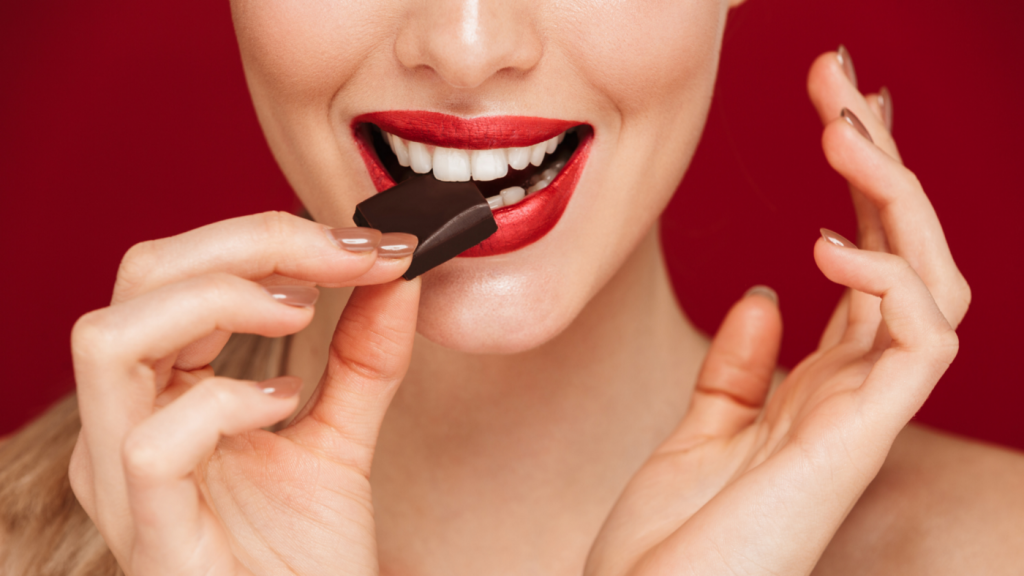Daily Archives: July 3, 2021
“All you need is love but a little chocolate now and then doesn’t hurt.”

Hi, my name is Marion Simms… and I’m a chocoholic.
In America, we love any excuse to eat a lot of chocolates, Valentine’s Day being one of them. Who can refuse those sweet treats in heart-shaped boxes? If your chocolate consumption concerns you, then it’s worth examining what the impact of all that indulgence will have on your skin.
While it’s true some women may notice a breakout a few days after eating a chocolate bar, sugar is to blame in this case, not chocolate. A diet high in fat and refined sugars, like those found in candy and chocolate, can kick sebum production into high gear and trigger inflammatory responses in the body — both of which are known to increase the risk of breakouts.
To get some clarity let’s start with a couple of interesting facts. A lethal dosage of chocolate for a human being is about 22 lbs (or 40 bars of Dairy Milk). On the other hand, one Smartie or an M&M would be enough to kill a robin or a blackbird. And if you eat a chocolate bunny every day you obviously run the risk of becoming uhm… well rounded.
However, David Asprey in his Bulletproof blog, explains many benefits of chocolate. Here are a few of them…
- Chocolate can improve your mood, cognitive performance and give you an energy boost.
- It is good for your cardiovascular health because of the polyphenols in cacao which can increase HDL cholesterol (or good cholesterol).
- And chocolate can help you maintain glowing skin by modulating healthy blood flow.
In a study, two groups of women consumed either a high flavanol (dark chocolate) or low flavanol (milk chocolate) cocoa powder for a period of 12 weeks. While the low flavanol group showed no change in markers of skin health, subjects in the high flavanol group had on average 25% reduction in UV-induced erythema (sunburn) after exposure to a solar simulator. The high flavanol group also recorded increased skin density and thickness, as well as better hydration and less transepidermal water loss — the evaporation of water through the outer layer of the skin.
Milk chocolate is definitely high in sodium and cholesterol but contains more calcium. Dark chocolate has less calcium but also much less cholesterol and sodium.
One of my favorite facials is a chocolate enzyme treatment which includes a blast of oxygen as well as an application of pure cacao powder. With the combination of the antioxidants (when you indulge!) working from the inside and the brightening, tightening benefits happening on the outside, you are guaranteed a healthy, glowing complexion.
As my dear Granny used to say: “A little of what you fancy does you good”. I say enjoy a moderate indulgence of darker chocolate — anything above 65% cacao — and reap the benefits of this much-loved treat. When eaten in the right quantity it can actually be considered a health food.
“Chocolate comes from cocoa, which is a tree. That makes it a plant… so chocolate is a salad.”
For more skincare tips, check out my other blogs on Medium, call us at Skinsense Wellness at (323) 653–4701 or visit our website. We offer a virtual consultation, in-salon treatments, and home service facials to our valued clients.
“I guess chemistry is just another word for love.” — Scott Thompson

Do you remember in 7th grade science where we would test vinegar and milk with a litmus paper and the paper would turn light pink or purple? Depending on the color that the paper turned that was it’s pH value. That’s how we first learned about the pH scale — the acidity and alkalinity of substances. We learned too how all these different acids and alkalines work together in our environment as well as our bodies to keep things running smoothly. Well, it’s the same thing with skin. That’s why it is not unusual to talk about the pH level of a skincare product.
The letters pH stand for potential hydrogen, as hydrogen is the element that controls the levels of either alkalinity or acidity in a formulation. Acidic products range from 0–6.9 and are often used to exfoliate or peel the skin; alkaline products range from 7.1–14 and can be used in cleansers or to neutralize acidity. Very often moisturizers are formulated to be neutral (a pH of 7) to bring the skin back into balance. Too much acid or alkalinity is irritating for the skin, so the pH is always carefully calibrated.
The optimal pH value of skin on most of our face and body lies between 4.7 and 5.75. As mentioned above a pH of 7 (that of pure water) is considered neutral. Anything below that is acidic and above it alkaline, so skin’s natural pH is mildly acidic. Skin maintains its barrier best around 5.5 — slightly acidic. At the ideal pH (5.5), the skin is able to maintain a good barrier (the acid mantle) and, together with natural oils, moisturizers and bacteria, function as a true protective defense organ.
More recently, the principle of pH balancing has been applied to our general wellbeing. This holistic approach believes that the foundation of healthy digestion is built on a simple eating system that maintains an ideal acid/alkaline (pH) balance in the body. 70% of the immune system is based in the abdomen and 90% of the tryptophan needed to make serotonin for the brain — essential to ensure we feel good — is made here. So in order to live a long and happy life it obviously pays to keep our abdomens happy!
As we all know, in the case of romance it is often quoted “the way to a man’s heart is through his stomach.” But what we are talking about here may not involve the foods and habits we are recommending!
And how does all this reflect in the skin? Well, too much acidity triggers eczema, inflammation, acne, boils, rosacea and wrinkles. So all of these conditions could be greatly improved by maintaining a more alkaline system. Obviously, exercise and relaxation are essential as well as drinking the right amount of water. Men need more water than women on a daily basis. If you eat plenty of vegetables and two or three fresh fruits a day, you can fill half your required fluid quota easily.
How do we do that? The suggested pH ratio would be a diet of two-thirds alkaline and one-third acid-forming foods. This takes some adjustment. So, to take a step in the right direction, let’s outline a few alkaline foods that we can incorporate in greater quantities and some acidic foods we can eliminate.
Raw, green leafy vegetables like chard, kale and spinach are all excellent alkaline-rich foods. So are avocados, celery, cucumbers, tomatoes, peppers, broccoli, coconut, cherries, grapefruit, lemons and watermelon. A healthy way to start and end each day with an alkaline system, for example, would be with a cup of warm water flavored with half a lemon. Also adding turmeric, garlic, ginger and flax seeds to your diet along with a good probiotic will keep the gut healthy and the skin glowing.
Things to avoid would be white flour, coffee, red meat, too much alcohol and artificial sugar. Also minimize your intake of fermented foods — they are acidic in nature. Stick to moderate amounts of sauerkraut, kimchi and pickles. These will add vitamins to your diet and anti-inflammatory benefits too.
For more information on the science behind beautiful glowing skin, call us at Skinsense Wellness at (323) 653–4701 or visit our website. We offer a virtual consultation and home service facials to our valued clients. Let’s talk!



